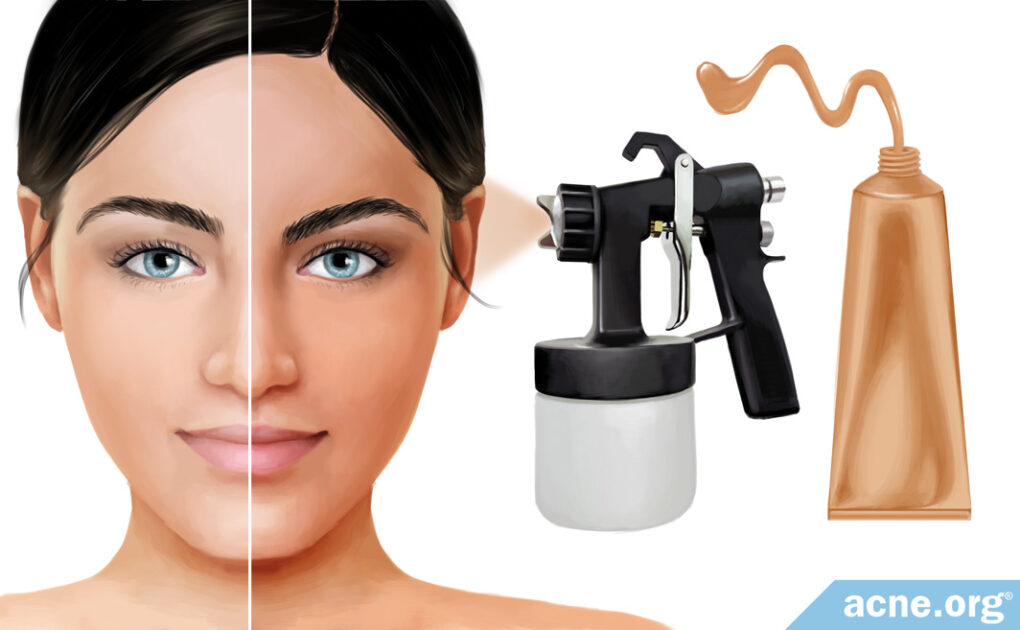No Studies Have Looked at Whether Self-tanners Are Safe for Acne. If You Use Self-tanners, Avoid Those with Pore-clogging or Irritating Ingredients and Apply Them Very Gently.

The Essential Info
Self-tanning products, also known as sunless tanners, can be purchased over-the-counter or sprayed on the skin in spray tan booths at salons.
Regardless of whether you apply a self-tanner yourself or pay to get a spray tan, the ingredients that artificially darken the skin are the same. These ingredients (DHA and/or erythrulose) react with surface skin cells to darken the skin surface and produce a darkening of the skin that slowly fades over the course of about a week.
No research studies have looked at whether these ingredients can trigger or aggravate acne, so it’s a risk to use them since we don’t know whether they affect acne one way or another.
If you do decide to use self-tanners:
Choose the Safest Product Possible: Choose a self-tanning product specifically advertised for the face. Look at the ingredients list before purchasing, and avoid any products with pore-clogging ingredients. If you’re getting a spray tan at a salon, ask for a list of ingredients from the store clerk.
Consider Avoiding Fragrances: If you are allergic or sensitive to fragrances, choose a fragrance-free product. This can be hard to find because almost all self-tanners are fragranced to mask the unpleasant odor of the tanning ingredients.
Apply Self-Tanners Gently: Apply self-tanners very gently without rubbing to avoid irritating the skin.

The Science
- Can DHA or erythrulose worsen acne?
- Guidelines for Choosing a Self-tanner for Acne-prone Skin
- List of Common Comedogenic Ingredients in Cosmetic Products
- Tips for Using Self-Tanners on Acne-prone Skin
Self-tanners, also known as sunless tanners, are topical cosmetic products for achieving a tanned appearance without the risks of sun exposure. Self-tanning products contain chemicals that darken surface skin cells, creating an artificial tan that lasts several days.
There are many types of self-tanners on the market, including lotions, gels, mousses, and sprays.
Self-tanners should not be confused with temporary bronzers and makeup bronzers. Bronzers create a tanned look by applying color to the top of the skin, and the color comes off at the end of the day with soap and water or a makeup remover. When it comes to self-tanners, the artificial tan they create cannot be washed off, and fades naturally over the course of about a week.1
Self-tanners typically contain one or both of these active ingredients:
- DHA (dihydroxyacetone): This is a white powder that comes from plants like sugar cane, but manufacturers typically produce it in commercial labs. It reacts with amino acids in the outermost layer of the skin to create a bronze tan. After a person applies a self-tanner with DHA to the skin, a bronze artificial tan begins to appear in 2-4 hours and continues to develop for 24-72 hours. The concentration of DHA in self-tanning products varies from 1 to 15%.2 The higher the DHA concentration, the darker the resulting artificial tan.
- Erythrulose: This is a clear liquid that naturally occurs in red raspberries, but manufacturers typically synthesize it in commercial labs. It reacts with amino acids in the outermost layer of the skin to create a reddish-brown tan. Erythrulose works similarly to DHA, but the artificial tan it produces takes longer to appear and fades faster than a DHA tan. Erythrulose works better when combined with DHA, and many people feel that the two chemicals together create a more pleasing tan color than erythrulose alone. Therefore, it is rare to find a self-tanner with just erythrulose. Most self-tanners on the market contain either DHA alone or DHA and erythrulose together.2
Can DHA or erythrulose worsen acne?
No research studies have directly explored the link between DHA or erythrulose and acne, so we do not know for sure whether these chemicals can aggravate acne.
However, there is some indirect evidence that DHA might hypothetically promote acne:
- A recent lab study published in the journal Redox Biology in 2020 reported that DHA induces a stress response in human skin cells. The researchers applied DHA to skin cells in the same concentration used in sunless tanners. They found that DHA stimulated the cells to release stress molecules.3 These molecules activate the body’s response to stress, including triggering inflammation. Inflammation is a key component of acne, so anything that increases inflammation in the skin might contribute to an acne flare-up. In other words, this study suggests that DHA might potentially worsen acne by increasing inflammation. However, since this study was performed on skin cells grown in the lab, we don’t know whether DHA would really worsen inflammation in people with acne.
- Experiments with skin samples in the lab suggest that DHA might trigger the skin to produce free radicals.4 Free radicals are naturally occurring toxins that can damage the skin and potentially stimulate acne. However, just because DHA might trigger these toxins in skin samples, it would be a stretch to conclude that DHA would worsen acne in real people.
- Research also shows that self-tanners containing DHA hamper the skin’s ability to produce vitamin D, which it normally produces during sun exposure.4 Vitamin D is important for the maintenance of skin health and might naturally counteract acne. However, it is difficult to say whether the temporary drop in vitamin D production from using a DHA-based self-tanner would have any noticeable effect on acne.
Finally, according to a few published clinical reports, DHA may cause an allergic reaction on the skin of some people.5,6 This is interesting to note, but does not tell us whether it will lead to acne.
In addition to DHA and erythrulose, self-tanners contain many other ingredients, some of which can potentially contribute to acne. If you decide to use self-tanners, follow these guidelines to minimize the risk of triggering a breakout:
Guidelines for Choosing a Self-tanner for Acne-prone Skin
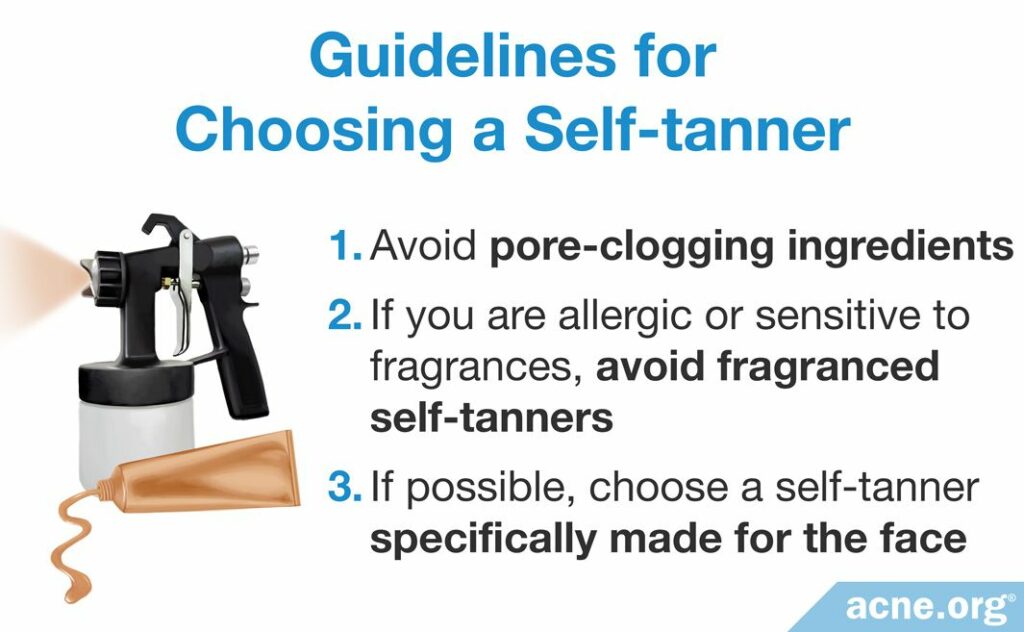
- Avoid pore-clogging ingredients: Before buying a self-tanning product, always check the ingredient list. Avoid self-tanners with comedogenic (pore-clogging) ingredients. The table below provides a complete list of common comedogenic ingredients. If you are going into a self-tanning spray booth, ask the clerk for a list of ingredients.
- If you are allergic or sensitive to fragrances, avoid fragranced self-tanners: Most self-tanners contain fragrances, which help to mask the unpleasant odor of the tanning chemicals.2 However, fragrances may cause allergies or irritate the skin in some people. Any kind of irritation can potentially make acne worse, so if your skin is sensitive to fragrances, it is best to select a fragrance-free product if you can find one.
- Consider choosing a self-tanner specifically intended for the face: Manufacturers may take more care in avoiding problematic ingredients when formulating products for the face. Therefore, products intended for the face may be a better option for people with acne-prone skin. However, it is still important to check the label for comedogenic or irritating ingredients.
List of Common Comedogenic Ingredients in Cosmetic Products
Many cosmetic products contain comedogenic ingredients.7,8 Based on all available research to date, here are two helpful lists:
- Definitely avoid: These are ingredients that people with acne-prone skin should definitely avoid, because a convincing body of evidence shows that they are comedogenic.
- Consider avoiding: These are ingredients that people with acne-prone skin may want to consider avoiding, because some evidence indicates that they might be comedogenic.
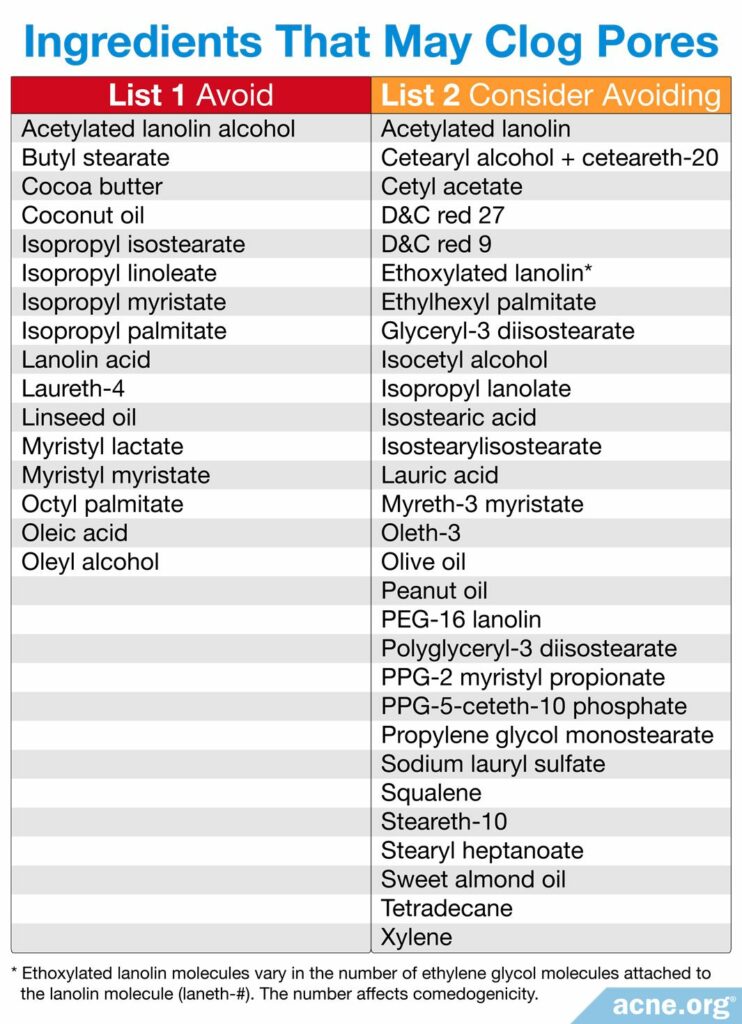
Tips for Using Self-Tanners on Acne-prone Skin
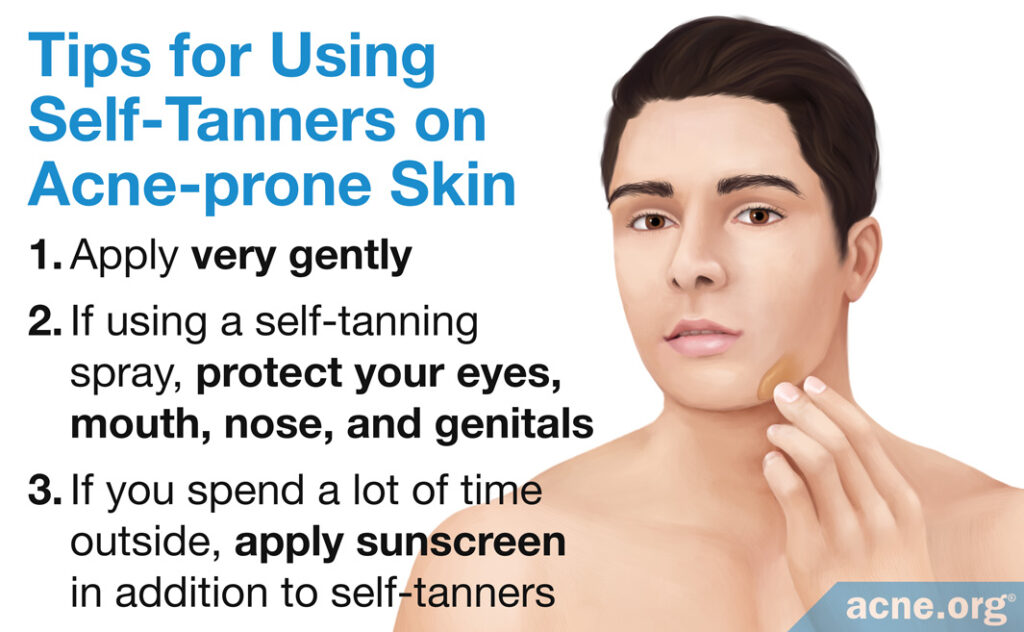
To use self-tanners safely and avoid aggravating your acne, keep these tips in mind:
- Apply very gently: Whenever you apply self-tanners to acne-prone skin, the most important thing is to avoid irritating the skin. Physical irritation is well-known to lead to increased acne symptoms. Manufacturers recommend applying self-tanners in a circular manner, which can mean going over the same spot multiple times. Therefore, it is critical to be very gentle and avoid rubbing the skin.
- If using a self-tanning spray, protect your eyes, mouth, nose, and genitals: Inhaling or swallowing DHA or having DHA come into contact with mucous membranes (the surfaces of the mouth, nose, genitals, and anus) can lead to side effects. If you use a self-tanning spray or go to a spray-tanning booth, wear protective eyewear, lip balm, nose filters, and undergarments.2,9
- If you spend a lot of time outside, apply sunscreen in addition to self-tanners: Unless manufacturers specifically include sunscreen ingredients, self-tanners only provide a very small amount of sun protection. If you spend a significant amount of time outside, it is vital to protect your skin from the sun’s rays by applying a separate broad-spectrum sunscreen in addition to your self-tanner.2,6 The exception is if your self-tanning product clearly indicates an SPF (sun protection factor) of 15 or higher on the label.
Self-tanner Ingredients: The Full Scoop
The first self-tanners appeared on the market in the 1960s.2
The main active ingredients in today’s self-tanning products are:
- Dihydroxyacetone (DHA):
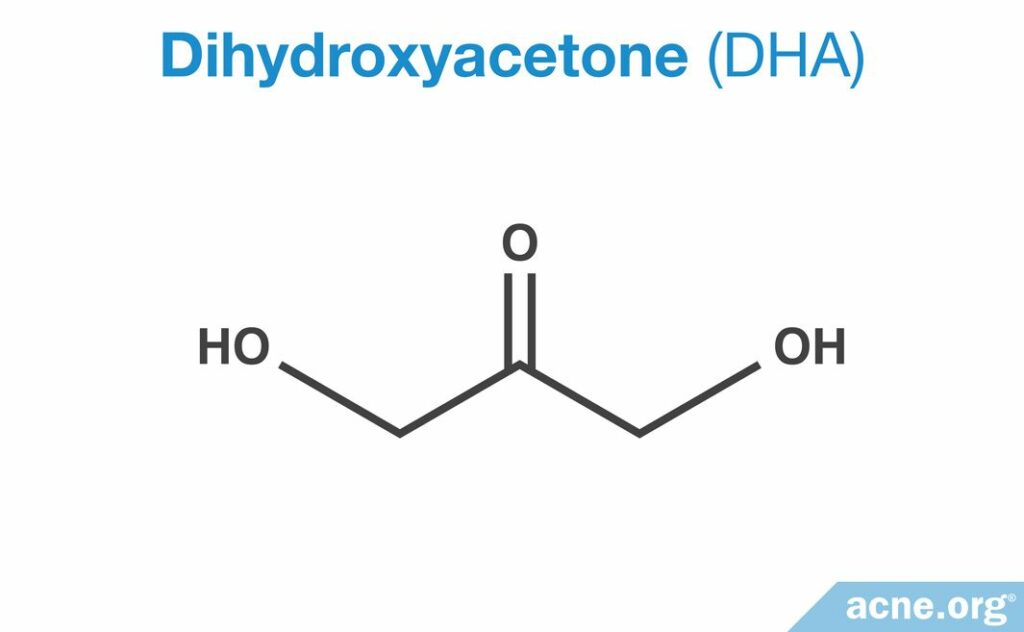
- Erythrulose:
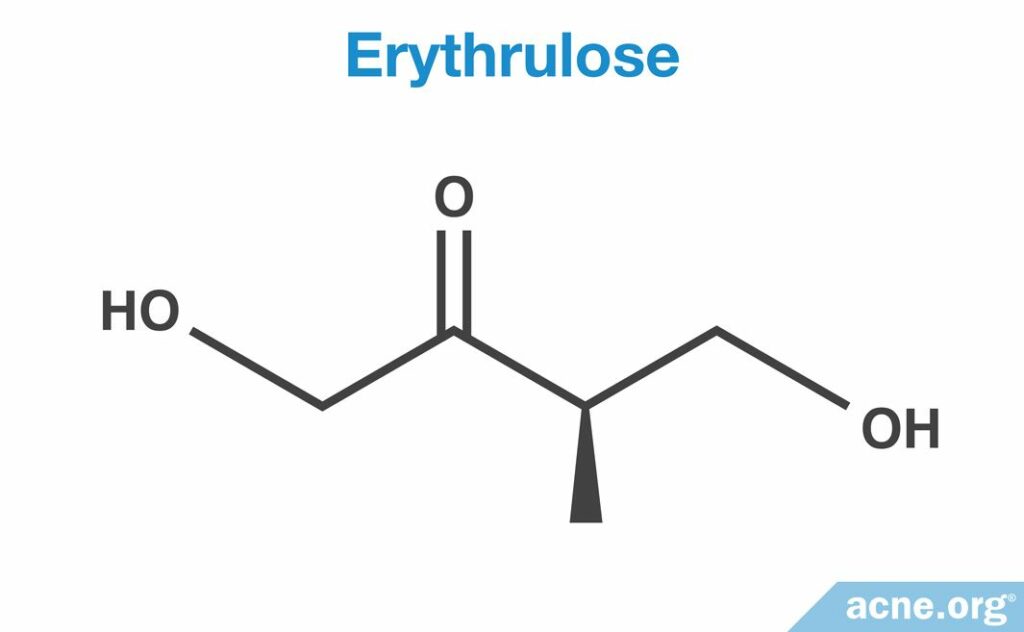
Both DHA and erythrulose produce an artificial tan by reacting chemically with amino acids in the outermost layer of the skin. This chemical reaction is called the Maillard reaction and produces pigmented substances called melanoidins inside the skin. These melanoidins give the skin a tanned appearance, which gradually disappears as the top layers of the skin are shed over the course of a week.1
Side effects of self-tanners
- Side effects of self-tanning sprays with DHA
The FDA (Food and Drug Administration), a US regulatory agency, has approved DHA for topical use, but not for use in spray-tanning booths. The agency does not recommend using self-tanning sprays containing DHA. DHA from sprays can accidentally enter the mouth, nose, or come in contact with mucous membranes, where it can cause side effects such as rashes, cough, dizziness, and fainting.2,9 If you use a self-tanning spray, make sure to cover your eyes, lips, nose, genitals, and anus. If you go to a spray-tanning booth, ask for protection such as special eyewear, undergarments, lip balms, and nose filters.
- Irritation and allergies due to self-tanners
A small number of published case reports shows that DHA sometimes causes an allergic skin reaction.5,6 If you develop skin irritation or itch after applying a self-tanner, stop using the product.
Many self-tanners include fragrances to mask the unpleasant smell that results when the active ingredients react with the skin. However, fragrances cause allergies and/or skin irritation in some people. According to an article published in 2015 in the Journal of Clinical and Aesthetic Dermatology, “Added fragrances can sometimes mask the smell; however, this may increase the likelihood of allergic reactions or worsen asthma symptoms.”2 If you are sensitive to fragrances, it is best to look for a fragrance-free self-tanner.
Artificial tan duration
The artificial tan from a self-tanner typically lasts 3-7 days. However, anything that speeds up exfoliation (the shedding of dead cells from the surface of the skin), such as scraping the skin, heavy sweating, and prolonged bathing, can speed up the fading of the tan. To achieve a longer-lasting tan, it is best to shower, shave, wax, and/or exfoliate the skin before applying self-tanners.2
Self-tanning products versus bronzers
Although both self-tanning products and bronzers create the appearance of tanned skin without sun exposure, they achieve this in different ways:1
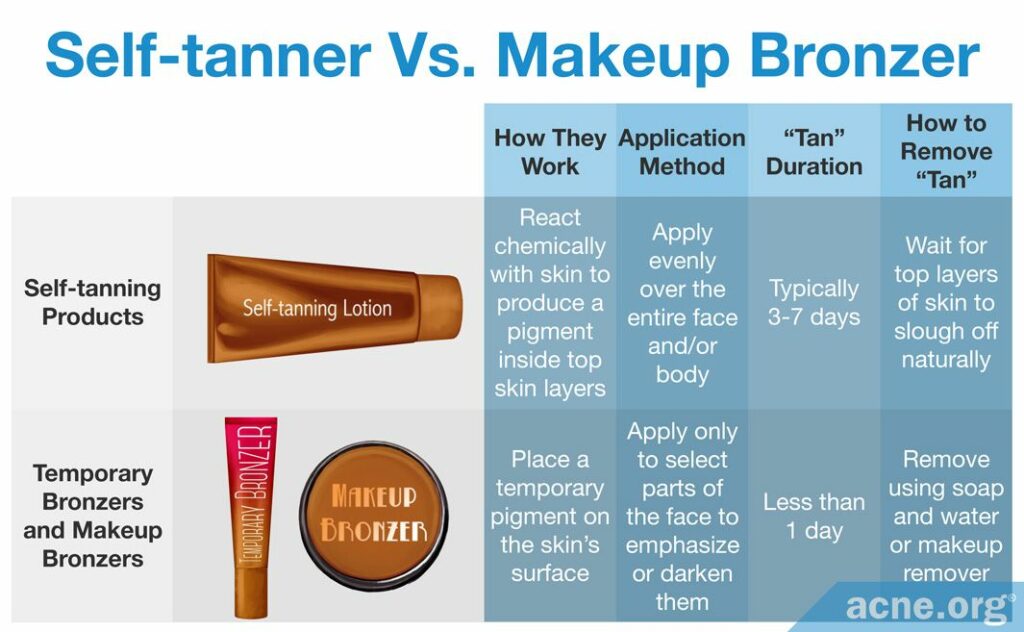
Self-tanners and sun protection
If you spend a lot of time in the sun, it is important to protect your skin from the sun’s rays. Excessive sun exposure can cause sunburn, and in people with acne, it can also contribute to so-called post-inflammatory hyperpigmentation (darkening of acne lesions after they heal).
Most self-tanners only provide a small amount of short-term sun protection equivalent to an SPF (sun protection factor) of 3. Research also shows that applying self-tanners with a DHA concentration of 5% or more makes the skin more susceptible to sun damage for up to 24 hours.2 Only self-tanners that are clearly labeled with an SPF of 15 or more provide adequate sun protection.9 Therefore, if you plan to spend a significant amount of time in the sun, it is very important to apply a separate broad-spectrum sunscreen product in addition to your self-tanner.
References
- Levy, S. B. Dihydroxyacetone-containing sunless or self-tanning lotions. (1992). Journal of The American Academy of Dermatology, 27, 989-93. https://www.ncbi.nlm.nih.gov/pubmed/1479107
- Garone, M., Howard, J., & Fabrikant J. A review of common tanning methods. Review. (2015). The Journal of Clinical and Aesthetic Dermatology, 8, 43-7. https://www.ncbi.nlm.nih.gov/pmc/articles/PMC4345932/
- Perer, J., Jandova, J., Fimbres, J., Jennings, E. Q., Galligan, J. J., Hua, A. & Wondrak, G. T. (2020). The sunless tanning agent dihydroxyacetone induces stress response gene expression and signaling in cultured human keratinocytes and reconstructed epidermis. Redox Biology, 36, 101594. https://pubmed.ncbi.nlm.nih.gov/32506039/
- Ciriminna, R., Fidalgo, A., Ilharco, L. M. & Pagliaro, M. Dihydroxyacetone: An updated insight into an important bioproduct. ChemistryOpen 7, 233-236 (2018). https://pubmed.ncbi.nlm.nih.gov/29531886/
- Bovenschen, H. J., Körver, J. E., & van der Valk, P. G. (2009). Contact dermatitis to self-tanning products. Contact Dermatitis, 60, 290-1. https://www.ncbi.nlm.nih.gov/pubmed/19397623
- Zokaie, S., Singh, S., & Wakelin, S. H. (2011). Allergic contact dermatitis caused by dihydroxyacetone – optimal concentration and vehicle for patch testing. Contact Dermatitis, 64, 291-2. https://www.ncbi.nlm.nih.gov/pubmed/21480916
- Kligman, A. M. & Mills Jr., O. H. (1972). Acne cosmetica. Archives of Dermatology, 106, 843 – 850. https://www.ncbi.nlm.nih.gov/pubmed/4264346
- Katoulis A. C., Kakepis E. M., Kintziou H., Kakepis M. E. & Stavrianeas N. G. (1996). Comedogenicity of cosmetics: a review. Journal of the European Academy of Dermatology and Venereology, 7, 115-119. https://onlinelibrary.wiley.com/doi/abs/10.1111/j.1468-3083.1996.tb00606.x
- Available from https://www.fda.gov/cosmetics/productsingredients/products/ucm134064.htm Accessed on 25/09/2017.
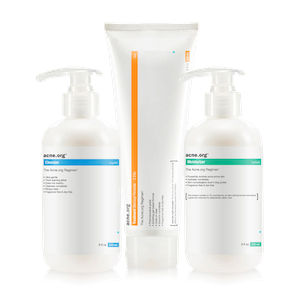 Acne.org Products
Acne.org Products